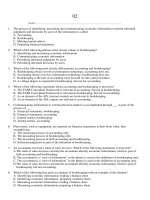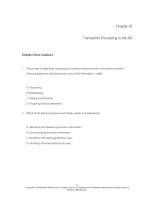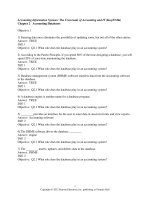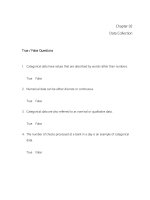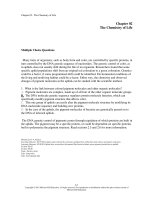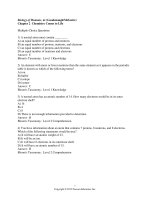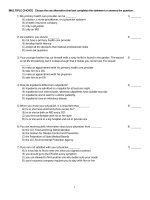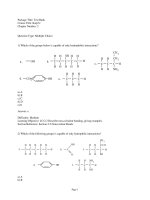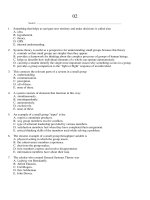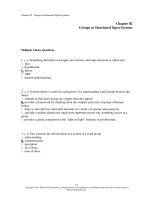Biology of humans concepts applications and issues 4th edition goodenough test bank
Bạn đang xem bản rút gọn của tài liệu. Xem và tải ngay bản đầy đủ của tài liệu tại đây (34.38 KB, 11 trang )
Biology of Humans, 4e (Goodenough/McGuire)
Chapter 2 Chemistry Comes to Life
Multiple-Choice Questions
1) A neutral atom must contain ________.
A) an equal number of protons and neutrons
B) an equal number of protons, neutrons, and electrons
C) an equal number of protons and electrons
D) an equal number of neutrons and electrons
Answer: C
Bloom's Taxonomy: Level 1 Knowledge
2) An element with more or fewer neutrons than the same element as it appears on the periodic
table is known as which of the following terms?
A) ion
B) buffer
C) isotope
D) isomer
Answer: C
Bloom's Taxonomy: Level 1 Knowledge
3) A neutral atom has an atomic number of 14. How many electrons would be in its outer
electron shell?
A) 14
B) 4
C) 8
D) There is not enough information provided to determine.
Answer: B
Bloom's Taxonomy: Level 2 Comprehension
4) You have information about an atom that contains 7 protons, 8 neutrons, and 8 electrons.
Which of the following statements would be true?
A) It will have an atomic weight of 23.
B) It will be an ion.
C) It will have 8 electrons in its outermost shell.
D) It will have an atomic number of 15.
Answer: B
Bloom's Taxonomy: Level 2 Comprehension
1
Copyright © 2012 Pearson Education, Inc.
5) Oxygen, with an atomic number of 8, is a neutral atom and would have ________ electrons in
the first electron shell and ________ electrons in the second electron shell.
A) 1; 7
B) 5; 3
C) 4; 4
D) 2; 6
E) 3; 5
Answer: D
Bloom's Taxonomy: Level 2 Comprehension
6) The compound magnesium chloride (MgCl2) turns into Mg++ and Cl- when placed in water.
You can guess that the Mg and Cl atoms are held together normally by a(n) ________ bond.
A) covalent
B) electronegative
C) hydrogen
D) ionic
Answer: D
Bloom's Taxonomy: Level 3 Application
7) The Cl ion has a single negative charge and the atomic number of 17. How many electrons are
on its innermost shell?
A) 18
B) 17
C) 9
D) 2
Answer: D
Bloom's Taxonomy: Level 2 Comprehension
8) Which of the following monomers is not paired correctly?
A) glucose-carbohydrates
B) amino acids-proteins
C) nucleotides-nucleic acids
D) All of these are paired properly.
Answer: D
Bloom's Taxonomy: Level 1 Knowledge
9) In what ways are hydrogen bonds and ionic bonds similar?
A) Both are based on attraction between atoms that carry differences in electrical charge.
B) Both are based on attraction between two atoms that carry negative charges.
C) Both are based on repulsion between atoms that carry differences in electrical charge.
D) Both involve an even sharing of electrons between atoms.
E) Both are based on attraction between two atoms that carry positive charges.
Answer: A
Bloom's Taxonomy: Level 2 Comprehension
2
Copyright © 2012 Pearson Education, Inc.
10) What is the difference between covalent and ionic bonds?
A) Covalent bonds are the sharing of electrons, whereas ionic bonds are the sharing of protons.
B) Covalent bonds involve the attraction between slightly charged molecules, whereas ionic
bonds involve the attraction between two fully charged ions.
C) Covalent bonds involve the sharing of neutrons, whereas ionic bonds involve the attraction of
slightly charged atoms.
D) Covalent bonds are the sharing of electrons, whereas ionic bonds involve the transfer of
electrons from one atom to another.
Answer: D
Bloom's Taxonomy: Level 2 Comprehension
11) The interaction between two polar molecules would involve ________.
A) ionic bonds
B) peptide bonds
C) covalent bonds
D) hydrogen bonds
Answer: D
Bloom's Taxonomy: Level 2 Comprehension
12) A substance consisting of weak acids or bases designed to maintain a specific pH of a
solution within a cell or a biological system would be which of the following?
A) buffer
B) catalyst
C) pH
D) acids
Answer: A
Bloom's Taxonomy: Level 1 Knowledge
13) The pH scale measures ________.
A) OH- concentration
B) buffer concentration
C) H+ concentration
D) All of the above are true.
Answer: C
Bloom's Taxonomy: Level 1 Knowledge
14) Any substance that when dissolved in water will give off H+ ions is referred to as a(n):
A) pH.
B) buffer.
C) catalyst.
D) acid.
Answer: D
Bloom's Taxonomy: Level 1 Knowledge
3
Copyright © 2012 Pearson Education, Inc.
15) A substance in which other substances are dissolved is known as what?
A) solute
B) acid
C) solvent
D) buffer
Answer: C
Bloom's Taxonomy: Level 1 Knowledge
16) Your roommate is experiencing heartburn and asks you to purchase her an antacid.
Chemically speaking, you know that the antacid will help eliminate her pain because ________.
A) it is a buffer and will prevent the pH in her digestive tract from changing
B) it has a low H+ concentration to increase the pH in her digestive tract
C) it is probably high in H+
D) it has a low pH to balance the acidity in her digestive tract
Answer: B
Bloom's Taxonomy: Level 3 Application
17) If I tested your intestinal fluid and found that it was basic, which of the pH values listed
would best describe this solution?
A) 6.8
B) 3.2
C) 1.2
D) 8.0
Answer: D
Bloom's Taxonomy: Level 2 Comprehension
18) A molecule consisting of a long chain of glucose monomers linked by covalent bonds that
serves as an energy source for plants and animals would be which of the following?
A) polysaccharide
B) oligosaccharide
C) monosaccharide
D) sucrose
Answer: A
Bloom's Taxonomy: Level 1 Knowledge
19) Which of the following carbohydrates is made by plants and is not digested by humans?
A) lactose
B) starch
C) cellulose
D) glycogen
Answer: C
Bloom's Taxonomy: Level 1 Knowledge
4
Copyright © 2012 Pearson Education, Inc.
20) Saturated fatty acids are so named because they are saturated with ________.
A) hydrogen.
B) nitrogen.
C) carbon.
D) oxygen.
Answer: A
Bloom's Taxonomy: Level 1 Knowledge
21) Triglycerides ________.
A) are fatty acids bonded to glycerol through hydrolysis
B) have solid unsaturated form at room temperature, such as butter
C) can provide twice the energy per gram than proteins
D) All of the above are true.
Answer: C
Bloom's Taxonomy: Level 1 Knowledge
22) Regulatory lipids that control metabolic processes or cellular functions are called ________.
A) triglycerides
B) carotenoids
C) phospholipids
D) steroids
Answer: D
Bloom's Taxonomy: Level 1 Knowledge
23) The hydrogen, ionic, and covalent bonds that stabilize the shape of a protein contribute to
which level of structure of a protein?
A) primary
B) quaternary
C) secondary
D) tertiary
Answer: D
Bloom's Taxonomy: Level 1 Knowledge
24) Alteration of the ________ structure of a protein can transform the protein into an infectious
agent known as a prion.
A) primary
B) secondary
C) tertiary
D) quaternary
Answer: B
Bloom's Taxonomy: Level 1 Knowledge
5
Copyright © 2012 Pearson Education, Inc.
25) Which of the following is not found in ATP?
A) a nitrogen-containing base
B) a sugar
C) a phosphate group
D) All of these are found in ATP.
Answer: D
Bloom's Taxonomy: Level 1 Knowledge
26) An organic compound that provides instructions for the synthesis or production of
polypeptide chains is referred to as which of the following?
A) nucleotide
B) lipids
C) ATP
D) DNA
Answer: D
Bloom's Taxonomy: Level 1 Knowledge
27) You received your genetic material from your parents in the form of DNA. Your DNA
provides your cells with instruction for making ________.
A) lipids
B) proteins
C) polysaccharides
D) cholesterol
Answer: B
Bloom's Taxonomy: Level 2 Comprehension
28) A researcher suspects that the food in an ecosystem has been contaminated with radioactive
phosphates over
a period of months. Which of the following substances could be examined for radioactive
phosphate to test the hypothesis?
A) the amino acids within proteins produced by organisms living in the area
B) the starch produced by plants in the area
C) the DNA of the organisms in the area
D) All of the above are true.
Answer: C
Bloom's Taxonomy: Level 3 Application
29) By analyzing the chemical formulas, you can determine that this molecule,
CH3CH(NH2)COOH, is a(n) ________, whereas the molecule C5H10O5 is a(n) ________.
A) cholesterol; amino acid
B) amino acid; sugar
C) nucleotide; glycerol
D) fatty acid; sugar
Answer: B
Bloom's Taxonomy: Level 3 Application
6
Copyright © 2012 Pearson Education, Inc.
30) Based on your knowledge of the chemical composition of humans, your body would contain
the largest amount of ________.
A) oxygen
B) potassium
C) sodium
D) phosphorous
Answer: A
Bloom's Taxonomy: Level 2 Comprehension
Fill-in-the-Blank Questions
1) A polysaccharide that is made by plants and can be digested by humans is ________.
Answer: starch
Bloom's Taxonomy: Level 1 Knowledge
2) A molecule with hydrophobic properties and polar molecular attributes would be called a(n)
________.
Answer: lipid
Bloom's Taxonomy: Level 1 Knowledge
3) A protein that speeds up chemical reactions without being consumed in the process is called
a(n) ________.
Answer: enzyme
Bloom's Taxonomy: Level 1 Knowledge
4) A(n) ________ consists of many monomer subunits bonded together in order to produce a
large molecule.
Answer: polymer
Bloom's Taxonomy: Level 1 Knowledge
5) A(n) ________ is a nonprotein substance that aids in forming the enzyme-substrate complex
in metabolic reactions.
Answer: cofactor
Bloom's Taxonomy: Level 1 Knowledge
6) ________ is the process of using water to break down polymers to their monomer subunits.
Answer: Hydrolysis
Bloom's Taxonomy: Level 1 Knowledge
7) ________ refers to a structure of a protein in which two or more polypeptide chains bind
together to form a functional protein.
Answer: Quaternary
Bloom's Taxonomy: Level 1 Knowledge
8) Lipids that regulate metabolic processes in biological systems are called ________.
Answer: steroids
Bloom's Taxonomy: Level 1 Knowledge
7
Copyright © 2012 Pearson Education, Inc.
9) Partially hydrogenated fats are also referred to as ________ fats.
Answer: trans
Bloom's Taxonomy: Level 1 Knowledge
10) A substance that, when disassociated in water, will give off hydrogen ions is referred to as
a(n) ________.
Answer: acid
Bloom's Taxonomy: Level 2 Comprehension
11) Atoms that have the same number of protons but differ in the number of neutrons are called
________.
Answer: isotopes
Bloom's Taxonomy: Level 1 Knowledge
12) The ________ can be used to measure whether a substance is an acid or a base.
Answer: pH scale
Bloom's Taxonomy: Level 1 Knowledge
13) A(n) ________ is a polymer that forms muscle, bone, hair, and other structural components
of the body.
Answer: protein
Bloom's Taxonomy: Level 2 Comprehension
14) The energy storing polysaccharide that can be found mainly in liver and muscle cells is
called ________.
Answer: glycogen
Bloom's Taxonomy: Level 2 Comprehension
15) A(n) ________ is a substance that accepts hydrogen ions or when disassociated in water will
give off hydroxide ions.
Answer: base
Bloom's Taxonomy: Level 2 Comprehension
8
Copyright © 2012 Pearson Education, Inc.
Matching Questions
Match each definition in the first column to the correct term in the second column.
A) Monosaccharides
B) Triglycerides
C) Compound
D) Denaturation
E) Element
F) Polarity
G) Active site
H) Tertiary structure
I) Hydrogen bonds
J) Amino acids
1) Weak bonds that function to stabilize water and nucleic acids such as DNA.
Bloom's Taxonomy: Level 1 Knowledge
2) A substance made up of two or more elements whose properties are usually different from
those of the substance.
Bloom's Taxonomy: Level 1 Knowledge
3) The site where a substrate binds to an enzyme.
Bloom's Taxonomy: Level 1 Knowledge
4) A process that causes a three-dimensional protein to change shape, resulting in the loss of
biological function.
Bloom's Taxonomy: Level 1 Knowledge
5) The tendency of a molecule to have positive and negative regions.
Bloom's Taxonomy: Level 1 Knowledge
6) The overall three-dimensional shape of a protein.
Bloom's Taxonomy: Level 1 Knowledge
7) A pure form of matter that cannot be broken down to simpler forms.
Bloom's Taxonomy: Level 1 Knowledge
8) The basic monomer of a protein that can be joined by peptide bonds using dehydration
synthesis reactions.
Bloom's Taxonomy: Level 1 Knowledge
9) Lipid molecules composed of one glycerol and three fatty acids that can be saturated,
unsaturated, or polyunsaturated.
Bloom's Taxonomy: Level 1 Knowledge
9
Copyright © 2012 Pearson Education, Inc.
10) The smallest molecular units of carbohydrates, also known as simple sugars.
Bloom's Taxonomy: Level 1 Knowledge
Answers: 1) I 2) C 3) G 4) D 5) F 6) H 7) E 8) J 9) B 10) A
Short Answer and Essay Questions
1) Explain some of the modern uses for radioisotopes in society.
Answer: Radioisotopes can be used in a variety of medical applications for diagnosis (imaging,
such as by radioactive iodine) or therapy (such as when radioactive seeds are used to treat
prostate cancer). Although not discussed in the chapter, other uses include iodine and phosphorus
isotopes being used to sequence DNA and RNA for medical, forensic, and criminal applications.
Many isotopes have been used for a variety of dating in geological fields (e.g., carbon 14 has
been used to date fossils).
Bloom's Taxonomy: Level 3 Application
2) Explain the major differences between covalent and ionic bonding.
Answer: In covalent bonding, electrons are shared between atoms. In ionic bonding, two
oppositely charged ions are attracted to each other.
Bloom's Taxonomy: Level 2 Comprehension
3) Explain the relationship between nucleic acids and proteins. How would a change to the DNA
ultimately affect proteins?
Answer: DNA is a nucleic acid that codes for specific amino acids that make up the proteins in
the cell and in living organisms. The exact amino acid sequence is vital in producing a functional
protein. Because the code is in the DNA and the DNA is in the nucleus, the DNA must be
transcribed into RNA molecules that are translated into the specific amino acid sequence. A
mutation occurs if the DNA has alterations in the code or if there is a mistake in the
transcriptions or translation process. A change to the DNA would ultimately change the sequence
of amino acids in a protein.
Bloom's Taxonomy: Level 3 Application
4) Radioactive iodine (131I) is commonly used in medical situations for the diagnosis and
treatment of thyroid conditions. The most common isotope of iodine that is not radioactive is
127I. Chemically, what is different between 127I and 131I? What is the same between them?
Answer: The difference between the two isotopes of iodine is their weights (or mass). This is
due to a difference in the number of neutrons present in each isotope. These isotopes have in
common their atomic number (number of protons), which is what makes them both iodine.
Bloom's Taxonomy: Level 3 Application
10
Copyright © 2012 Pearson Education, Inc.
5) Athletes are often told to eat starch before a strenuous athletic event. What monomer can be
released from starch after hydrolysis, and what is it used for? Because cellulose (fiber) is made
of the same type of monomer as starch, why aren't athletes told to eat fiber before an event?
Answer: When starch is broken down, glucose is released. This glucose can be used during
cellular respiration to produce energy (ATP) for the cells. Cellulose, like starch, is also
composed of glucose monomers; however, we lack the enzymes necessary to perform hydrolysis
on cellulose. Therefore, the glucose cannot be used by the cells in order to produce ATP.
Bloom's Taxonomy: Level 4 Analysis
6) Within your body, there are two major categories of hormones. One category is the steroid (or
lipid-soluble) hormones, and the other category is referred to as nonsteroid (or water-soluble)
hormones, which are composed of proteins or amino acids. Estrogen and testosterone are
examples of steroid hormones, whereas insulin is an example of a nonsteroid hormone. A
researcher heats estrogen, testosterone, and insulin to a very high temperature. After heating the
hormones, the researcher tests to determine whether they still work properly. She finds that
estrogen and testosterone still function, but insulin does not. Based on the chemical nature of
these molecules, explain why insulin no longer functions.
Answer: Given that the insulin is a peptide hormone, it is protein based. Proteins require a
specific shape to function properly. Heat is one factor that can denature a protein, damaging its
shape so that it can no longer function properly.
Bloom's Taxonomy: Level 4 Analysis
7) Your friend tells you that all dietary fat is bad for your health. Is this correct?
Answer: Although excess fat can be harmful, especially to the circulatory system, fat does serve
important functions in the body including long-term energy storage, insulation, and protection
from blows.
Bloom's Taxonomy: Level 3 Application
8) When new food products are being analyzed for nutritional content, the food will be subjected
to hydrolysis in the lab. The end products are analyzed to determine things such as fat and sugar
content. Suppose a lab is analyzing a new product that claims to be fat free. After the hydrolysis
of the product is complete, they find glucose, glycerol, hydrocarbons, and amino acids. Is this
product free of fat? Justify your answer.
Answer: This product is not fat free. It contains hydrocarbons, which are fatty acids. It also
contains glycerol. Because fats are composed of a glycerol molecule and three fatty acids, this
product contains all components found in fat.
Bloom's Taxonomy: Level 4 Analysis
11
Copyright © 2012 Pearson Education, Inc.
